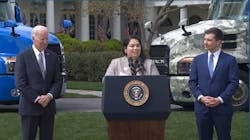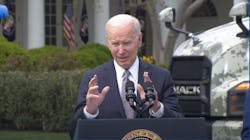Biden admin details plan to boost truck driver jobs
Each year, 300,000 truck drivers leave the profession. That’s according to U.S. Department of Transportation estimates, which serve as a backdrop for a greater push by the Biden administration with its Trucking Action Plan.
Last December, DOT and the U.S. Department of Labor launched the action plan, which is made up of public-private initiatives to increase the supply of truck drivers by creating new pathways into the profession, expanding training through registered apprenticeships, and laying the foundation for improving job quality to keep people in the profession.
In what he referred to as a “90-day sprint to get these actions off the ground,” Transportation Secretary Pete Buttigieg provided an update on the administration’s progress on the action plan during an April 4 event at the White House.
Cutting red tape in commercial driver’s licensing: DOT gave states $57 million in federal funds, as well as technical assistance, to more than double new commercial driver’s license issuances in January and February compared to January and February 2021. States have issued more than 876,000 CDLs since this January, according to the administration.
Scaling registered apprenticeships in trucking to improve retention: More than 100 companies, including Domino’s, Frito-Lay, and UPS launched Registered Apprenticeship programs in 90 days as the Labor Department cut the amount of time it takes to launch a program from months to as little as 48 hours, President Joe Biden pointed out during the event. This could result in more than 10,000 additional apprentices, according to his administration.
Helping connect veterans to trucking careers: The trucking industry partnered with veterans service organizations to launch Task Force Movement: Life-Cycle Pathways for Veterans and Military into Trucking, chaired by a former congressman and veteran, Patrick Murphy, to support the recruitment and retention of veterans and military family members.
“And of course, we are fixing roads and bridges across America,” Buttigieg said. “One trucker told me ‘infrastructure is our workplace.’ Now, we are enhancing that workplace. That includes working with states to use that funding for more safe truck parking because we know that is an essential issue for truckers today.”
“This is just the beginning,” he added. “We are going to keep our foot on the gas to deliver for drivers who deliver for us every single day.”
See also: Industry still behind in race for enough truck parking spaces
The bipartisan infrastructure law includes funding in at least five programs that states can use to address truck parking. It also requires states to include an analysis of truck parking needs in their state freight plans.
Addressing driver challenges
During the event, Maria Rodriguez, a first-generation immigrant from Venezuela who recently became a truck driver apprentice for NFI, explained how her newfound career in trucking has provided the financial stability and flexibility needed to support her family.
“My family and home time are everything to me, so I knew NFI would be my top choice,” Rodriguez told White House attendees. “I was offered the apprenticeship opportunity and received hands-on training and mentorship—all while being paid while I continue to learn.”“The trucking industry is in high demand, and there are jobs here that can support our family,” she added. “As an essential part of the supply chain, I feel like I am a part of something bigger than myself, which is very rewarding.”
Biden’s action plan also includes a Women of Trucking Advisory Board that will review and report on challenges facing women drivers, such as on-the-job safety risks, mentorship, quality training, and opportunities for advancement.
The plan also includes a Truck Leasing Task Force to address predatory truck leasing arrangements and identify actions that could make leases more equitable and transparent, the administration noted.
Driver detention time was also a problem highlighted during the event.
“Trucking moves about 70% of all the goods in this country,” Biden said. “Truck drivers are facing real challenges. The average driver waits four and a half hours for the truck to be loaded and unloaded during an 11-hour shift, and they don’t get paid for that wait time.”As part of the plan, DOT is studying driver detention time and its impact on safety and compensation. This work will provide a detailed understanding of wait time’s effects on drivers across jurisdictions and industry sectors. DOT is also partnering with the National Academies of Science to study the impact various methods of driver compensation have on safety and retention.
“Back in 1978, the average truck driver’s pay was $34 an hour in today’s dollars,” Biden emphasized. “Last year, it was $25 an hour—nearly a 30% decline in this iconic American industry that is getting harder and harder. It’s no surprise so many drivers left their jobs, and the workforce is getting older.”
Trucking associations react
A fierce advocate for more truck parking and other driver-related issues, the Owner-Operator Independent Drivers Association released the following statement in response to the April 4 event:
“The Biden Trucking Action Plan remains a mixed bag of policies intended to improve jobs and employment opportunities within the industry. We applaud the administration for adding truck parking to the plan and agree that the lack of parking across the country is about more than just inconvenience. OOIDA is also pleased that DOT along with other federal agencies has started gathering information on critical issues like detention time and driver compensation. However, drivers are still waiting on meaningful measures that will help address these problems. Today’s update notes significant progress on establishing apprenticeship programs and plenty of funding to help states expedite CDLs, but we have yet to really see any substantive actions that can help keep new or current drivers in the industry long-term.”
In addition, nine professional truck drivers and nearly two dozen CEOs from American Trucking Associations member companies attended the event to tout trucking apprenticeships. In March, ATA signed an agreement with the Department of Labor establishing the association as an official registered apprenticeship sponsor.“Investing in our workforce never stops. It’s a constant,” ATA President and CEO Chris Spear said in a statement prior to the event. “Our industry needs an additional 80,000 commercial truck drivers if we’re to meet consumer demand. We welcome the support of all elected officials as we recruit and train more talent into this critical industry.”
“Recognizing our dedication to training and safety, the Departments of Labor and Transportation have worked quickly and efficiently in approving ATA as a registered apprenticeship sponsor,” Spear added. “This long-sought designation provides our member companies valuable new tools and resources to help recruit and train the next generation of trucking talent.”
About the Author

Cristina Commendatore
Cristina Commendatore is a past FleetOwner editor-in-chief. She wrote for the publication from 2015 to 2023.




